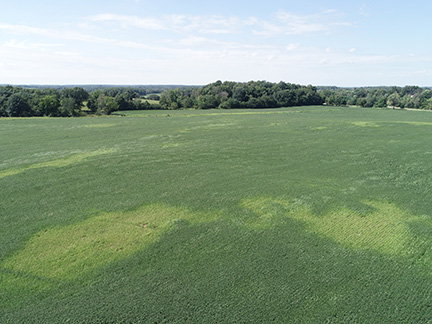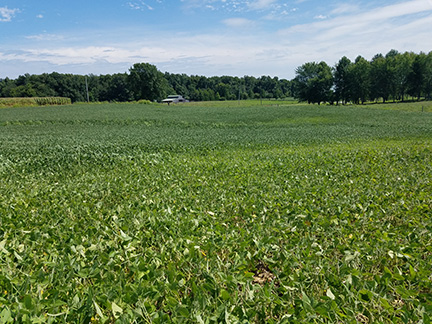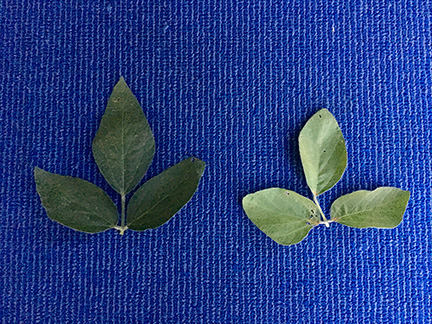We are accustom to a sea of dark green soybeans during the month of August, so it is troubling when we see areas in our fields that turn highlighter green (Figure 1). Soybeans have typically reached their final height, developed their last leaf, and peaked in nitrogen (N) fixation during this month (basically, R5 to R6). In other words, soybeans finish the vegetative growth and transition fully to reproductive development and growth (i.e., pod retention and seed fill).

Figure 1. Highlighter green soybeans (N-deficient) showing up in fields across Indiana. (Photo taken Aug. 24, 2018 in Warren County by Jon Charlesworth, Purdue Extension, Benton County ANR).
Unfortunately, many soybeans across the state have been coming up short on N over the past several weeks (Figure 2). This problem has been building at various points across the season, but fully being expressed now due to the N demands the plant requires during seed fill and the field conditions of the past month or so. The root cause of the highlighter green soybeans (i.e., N-deficient) is literally at the roots! Nodulation and N fixation have been hit more this season with frequent and substantial wet feet. The wet conditions push out the oxygen in the pore space for the soil, which can lead to root and nodule death depending on duration.

Figure 2. Highlighter green soybeans (N-deficient) in the foreground vs. healthy, dark green soybeans in the background. (Photo taken Aug. 27, 2018 in Warren County by Kelly Pearson, Purdue Extension, Warren County ANR).
The first step is to dig up the good (i.e., dark green) and the bad (i.e., highlighter green) areas to investigate the root systems in particular the nodule load and activity (Figure 3). As you dig in these areas, please be aware of the ease or difficulty to push the spade into the soil. In other words, you are assessing the degree of compaction that could be limiting root development and the restriction to water flow. An investigation of the soybean roots, should also indicate if they have experienced any sidewall compaction, tire compaction, tillage pan, etc. In most every case, the highlighter soybeans have had a compromised root system, fewer nodules, and limited nodule activity (pink vs. white interior). If you want further confirmation that this is N deficiency, I suggest taking leaf samples of the good and bad areas for nutritional content (look at S level too) (Figure 4).

Figure 3. LEFT – Healthy, dark green soybeans with bigger root system with many active nodules. RIGHT – N-deficient soybeans (highlighter green) with limited nodules. August 23, 2018 near Columbia City.

Figure 4. Taking proper leaf samples (most recent mature leaves are typically the 3rd to 4th trifoliate from the top of the plant) to help diagnose the N deficiency. LEFT – Healthy, soybean leaf. RIGHT – N-deficient soybean leaf due to poor nodulation and N fixation.
We understand that soybeans need a good root system and nodule load/activity to maximize growth, development, and yield. Many of us have probably experienced compromised root systems and limited N fixation due to compaction and wet feet. The pattern of N deficiency in many fields is causing some confusion since it is not matching up with soil series, clay knobs, sand ridges, or the low lying areas. In fact, the N-deficient soybeans are showing up on the side slopes (please see the following article on “Seep Hydrology and Soybeans”). Other patterns do not match up with side slopes, but I wager that is related to the subsoil (perhaps, more on those situations next week).


